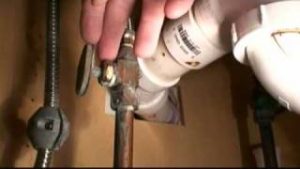Best approach for Finding the Source of a Small Water Leak in a Wall
By Mark J. Donovan
|
|
Question: I have a small water leak inside a wall. There are water supply lines and a waste line inside the wall that lead to an upstairs bathroom. Near the baseboard there are paint bubbles and moisture so there must be a leak on the other side of the wall. One side of the wall is drywall and the other side is plaster. The drywall side is completely dry, but it is probably the easiest way to cut into the wall partition to see what I am dealing with. How would you recommend I go about opening up a small portion of the wall to see what is the source of the leak is?
Answer: First. it is important to remember that where a leak is visible is not necessarily where the leak is originating from. |
This said, I would take a careful look in the upstairs bathroom first before cutting any holes in your walls. The likely source of the water leak is probably associated with the upstairs toilet, bathtub or sink. Carefully check these bathroom fixtures for leaks before contemplating cutting into the drywall/plaster. Specifically check around the valves and fittings to make sure they are not leaking. Also, take a careful look around the toilet, as the problem may be associated with a faulty toilet wax ring. If it is a faulty toilet wax ring, you potentially may see water leaking out from around the base of the toilet. If this is the case, you can turn off the toilet supply line and replace the toilet wax ring.
| If no leaks are observed, then one simple test you can perform is to leave the faucets off in the upstairs bathroom for awhile and see if the moisture problem dries up. If it does, then the water leak is most likely associated with a waste line or trap. If it was a supply line leak, then the water problem would persist even if the faucets were not used.
If there are no leaks around the supply lines in the upstairs bathroom and the problem dries up when you do not use the upstairs bathroom for a day or so, then yes you will probably need to cut into the drywall. |
 |
However, just remember the leak is probably higher up, e.g. in the tub or toilet drain trap area for example. Ultimately you may end up having to actually cut into the ceiling to get under a drain trap, as this is most likely the leaking area.
If you are still inclined to punch a hole in the wall to observe the source of the leak, I would certainly go in the drywall side versus the plaster side. However, you may want to go into the drywall near the ceiling. Again, you will probably wind up having to cut into the ceiling to actually get to the problem area. If you can identify the problem bathroom fixture ahead of time, e.g. such as the bathroom tub you may just want to skip cutting a hole in the wall and go right for the ceiling, underneath the tub.
For information on installing a shower pan membrane liner for a ceramic tile shower, see the Shower Pan Membrane Liner Installation eBook from HomeAdditionPlus.com. The Shower Pan Membrane Liner EBook will quickly teach you the step-by-step process for installing the shower pan membrane liner correctly. It includes instructions on framing the shower stall, pouring the pre-slope and shower base mortar, and installing the shower pan membrane liner.
For information on how to tile a custom ceramic tile shower, see the “How to Tile a Custom Ceramic Tile Shower eBook” from HomeAdditionPlus.com. This eBook will quickly provide you with step-by-step instructions on how to measure and install ceramic tile in a shower, including the installation of tile on shower walls, floors and curbs. It provides detailed instructions for every step in the process of tiling a custom ceramic tile shower and is loaded with instructional pictures!
Related Information
Additional Plumbing Resources from Amazon.com
 |
 |
Get Free Bathroom Remodeling Price Quotes with No Obligation!
Fill out our 3-5 minute quick and easy form, and receive a free price quote on a bathroom remodeling project from one of our pre-screened and licensed bathroom remodeling contractors. This process is free and there is no obligation to continue once you receive your bathroom addition price estimate.
